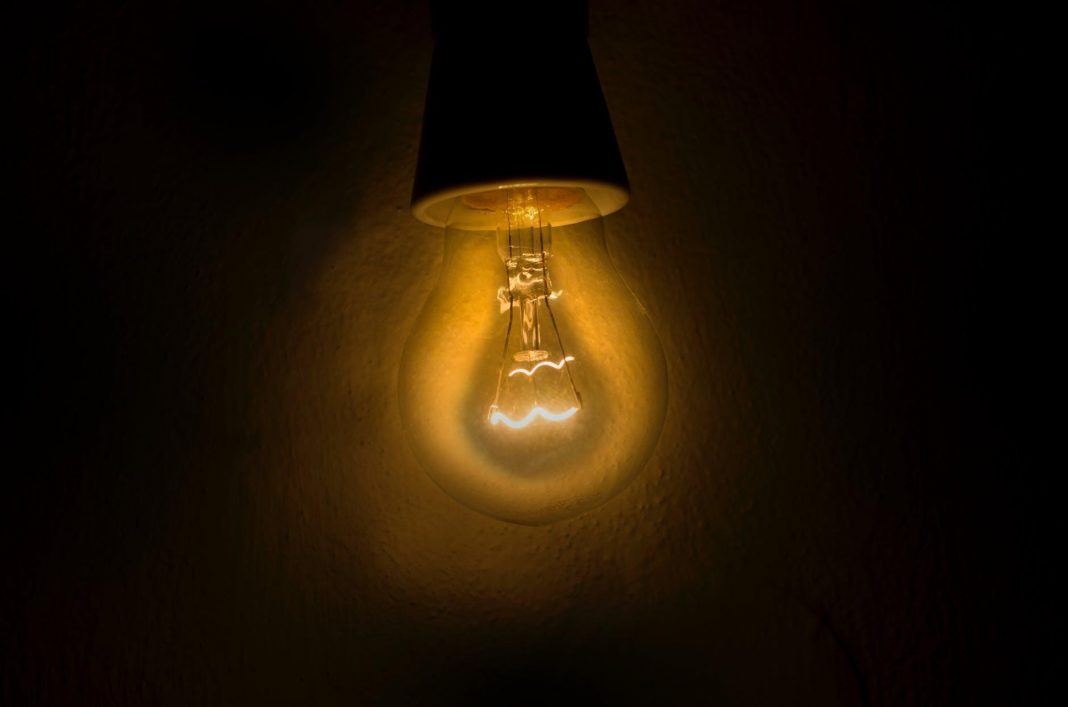 |
|
| Issue #92 • March/April, 2005 |
|
In our last issue, I discussed how to use solar energy to power a remote well pump. In this issue, I will describe how you can build a simple solar powered light. This is not one of those inexpensive solar walk lights sold in garden supply stores. This is a commercial quality light that can easily illuminate a parking area, remote outbuilding, dark driveway, or large road sign. Figure 1 shows the pole lamp version of this lighting system.
Main components
There are four components required to build any solar powered light: the solar array, high efficiency D.C. lamp, charge controller, and a battery. The solar array will be the most expensive component required, and these are now available in many different sizes and wattage ratings.
Figure 2 shows the rear view of a solar pole light. The solar array includes an adjustable pole mount which allows facing the solar array toward the south (in northern latitudes), with a tilt angle approximately equal to the latitude (30 to 40 degrees for most parts of the central United States). The weatherproof light fixture is mounted at a height and tilt that best illuminates the area desired.
Just under the solar array is a weatherproof, but vented, enclosure to house all electrical components. This will include a sealed no-maintenance battery and a solar charge controller. The charge controller protects the battery from over-charging, maximizes the charging voltage and current output of the solar array, and controls when the light operates.
|
Lighting fixture types
Figures 3 and 4 show one of the newest types of low-voltage DC light fixtures available. This is a 35-watt low-pressure sodium street light that includes built-in time controls. A standard plug-in photocell is mounted on the top, and the protective fixture housing includes switch controls to adjust the lamp start delay time and operating times.
Low-pressure sodium lighting appears brownish in color and is normally used to illuminate large parking areas and highways due to its long lamp life and very low energy requirements. This type of fixture is usually mounted on a tall pole to illuminate a large area when low light level and a non-white color spectrum is acceptable.
Figure 5 shows a 13-watt compact fluorescent fixture in an aluminum housing, now available for 12-volt DC operation. This fixture is commonly used for ground level mounting to illuminate up towards a sign or wall area.
Figure 6 shows a low-voltage compact fluorescent fixture with a non-metallic housing that includes a photocell. This fixture and lens design is intended to mount on the side of a wall to illuminate the ground area next to a building or over an entry. Both fixtures use a two-pin base, compact fluorescent twin-tube lamp, typically in the 9 or 13-watt size. Fixtures designed for use with very low wattage lamps maximize the light output by using a highly polished reflector behind the lamp, and a clear plastic focusing lens in front of the lamp.
System controls
|
Unlike most dusk-to-dawn photocell controls used with AC grid connected outdoor lights, most solar powered lighting applications do not operate the light continuously all night, as a way to reduce the solar array size and extend battery life.
In many northern latitudes, it is not unusual during cloudy winter months for a conventional photocell controlled outdoor light to turn on around 4 p.m. in the evening, and stay on until 7 a.m. the next morning.
Since short winter days may only provide four hours of solar energy collection time, it’s difficult to fully recharge a battery in this short period and then expect it to power a lighting load continuously for the next 15 hours.
Figure 7 shows two brands of solar battery charge controllers that include built-in lighting timer controls. The Trace C12 controller on the left of the photo provides good three-stage battery charging, plus provides on/off light control using the solar array as a photocell to signal when it gets dark.
For more sophisticated applications, the MorningStar Sunlight solar control on the right of the photo is an excellent choice. This controller is available in 10 and 20-amp versions, and for 12 and 24-volt DC applications. In addition to being a three-stage battery charge controller, an adjustable dial allows programming the light to stay “on” from 2 to 10 hours after sunset, to turn “off” then back “on” for 1 to 2 hours before sunrise, or simply to provide dusk-to-dawn operation. Some solar controllers also include a jumper to select between a flooded and sealed battery to maximize charging efficiency and extend battery life.
|
Putting it all together
Figure 8 shows a complete solar-powered sign lighting system we recently designed for an industrial park. The main entrance sign was located over a half mile from the nearest office building, which would have required trenching a long distance under a parking lot, street, and sidewalk.
The installation costs to run a conventional underground AC power line this far were higher than the cost of a self-contained solar powered lighting system. This installation has a 13-watt fluorescent fixture (see Figure 5) located in the planter box on each side of the sign, a pole-mounted solar array mounted next to the sign, and a weatherproof box located behind the sign which contains the charge controller and 12-volt gel-cell battery.
The sizing of the solar array, battery, and charge controller will depend on the wattage of lamp you choose, and how many hours you want it to operate each night. If your location is subject to frequent periods of cloudy weather, your battery needs to store energy for more than one day of lighting operation.
|
For example, let’s say you want to power a 13-watt fluorescent fixture an average of 4 hours each night. (13 watts x 4 hours)/ 12 volts = 4.33 amp-hour/day
Since there will be an efficiency loss during both the battery charging and battery discharging process, and additional efficiency losses for the fluorescent ballast, charge controller, and wiring, we need to add at least 30 percent more to our initial calculation. (4.3 amp-hour) x (1.3) = 5.8 amp-hour/day
If you want three days of continued operation during cloudy weather when there will be no solar charging, you will need a solar charged battery that can store three times this daily amp-hour value.
I strongly recommend buying a good quality sealed or gel-cell battery designed for daily deep discharge cycling. In addition, since the enclosure must be vented for safety in case of battery out-gassing, the battery life will be reduced due to the high and low outdoor temperatures it will experience. For these applications, most batteries will need replacement every three years.
Array sizing
|
Like the battery, the size of the solar array also depends on the lamp wattage and daily operating hours. Unless you live in a very southern or desert climate, a fixed south facing solar array will receive direct sunlight only from an average of 9 a.m. to 3 p.m. during summer months, and 10 a.m. to 2 p.m. during winter months.
This means a solar array having a 40-watt nameplate rating could generate 240-watt hours (40 watt x 6 hours) of power during a very sunny day. A 13-watt fluorescent lamp would operate 18 hours on this energy (240 watt-hour/13 watts), assuming no efficiency losses.
However, solar module nameplate ratings are based on lab testing under perfect solar conditions. Actual power output will vary for each hour of the day for different module orientations, and for constantly changing cloud cover and air temperature. If your lighting application is more demanding, you may need more than one solar module, or use a larger battery to guarantee the light will always be able to operate the hours required.
Wiring diagram
|
The wiring diagram I have included in Figure 9 shows a typical circuit to connect a solar array, battery, charge controller, and light fixture. Due to the lower 12-volt operation, the operating currents will be 10 times higher than the current required if this was a 120 volt AC light fixture having the same wattage lamp.
Therefore, I recommend using a minimum of 10-gauge stranded copper wire. Any wire exposed to sunlight and moisture needs to be rated for this type of service. In addition, since a solar module can be extremely hot during the summer, any wire used to connect to its rear terminals must also have a high temperature rating. A single conductor type “USE” cable is an excellent choice for solar applications and should meet all UL code requirements.
Also note that I have included a separate fuse to protect the battery and load side of this circuit. Keep all wiring runs short and use “crimp” type copper terminals to reduce voltage loss and improve long-term connector reliability. Be sure to use a #6 or larger solid copper wire to connect the solar module frame, light fixture, and mounting rack to a ground rod.
Conclusions
|
For estimating purposes, I recommend using a 40-watt solar array and 50 amp-hour capacity battery to power a 13-watt lamp five hours per night. For a 35-watt lighting load, you will need an 80 amp-hour or larger battery, and at least two 50-watt solar modules. Some parts of the United States may require higher values than these estimates. These values should provide at least three days of standby operation during cloudy weather without discharging the battery below its safe operating limit. Remember, repeated discharging of any battery below a 50 percent discharge level will significantly reduce battery life, and automotive type batteries cannot take this daily deep discharge cycling.
Finally, due to significant differences in weather conditions and solar availability in each area of the country, you may need to experiment with the light’s start and stop operating times to avoid excessive battery discharge.
If you like the idea of a solar powered outdoor light, but would prefer not to do-it-yourself, there are many packaged systems now available that are pre-sized for your specific location and lighting requirements.
Resources
DC Light Fixtures
Thin-Lite Corp
www.thinlite.com
805-987-5021
Solar Components
National Solar Supply
www.nationalsolarsupply.com
866-255-1829
Kansas Wind Power
www.kansaswindpower.net
785-364-4407
Backwoods Solar Electric Systems
www.backwoodssolar.com
208-263-4290
Complete systems
Power Pod Corp
www.powerpod.com
888-786-3374
[weaver_widget_area id=’articles_about_yago’ class=’text3′]






















